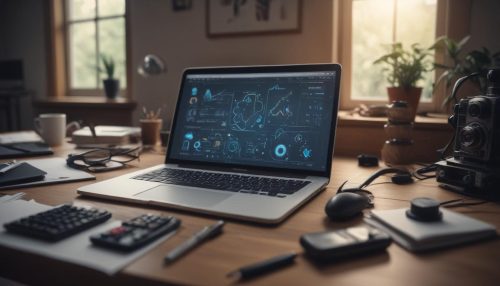How to Combat Digital Overload and Stay Productive
Brian Taylor June 13, 2025
In a world wired to our devices, digital overload has become a silent productivity killer. Notifications, apps, tabs, and endless messages fragment our focus, causing stress and reducing performance. Learning how to combat digital overload isn’t just helpful—it’s essential for anyone working, studying, or living in the digital age.
This guide explores the latest research, practical tactics, and tools designed to push back against digital distraction and regain control, so you can perform at your best.

What Is Digital Overload—and Why It Matters
Digital overload refers to the strain and diminished productivity resulting from excessive digital inputs—emails, alerts, multitasking, and tech demands. According to a ResearchGate review, this leads to interruption overload, work-life conflict, and stress that directly harm productivity. Insightful.io reports that technology can both empower and overwhelm depending on how it’s managed. Additionally, studies show reaching “digital saturation” results in mental exhaustion and reduced job performance.
In short: More tech doesn’t guarantee better work. Without boundaries, it burns us out.
The Real Costs of Digital Overload
- Mental fatigue & stress: Extended screen time linked to emotional exhaustion and burnout .
- Fragmented focus: Workers switch tasks every three minutes; full focus takes over 20 minutes to regain .
- Productivity losses: Nearly half of professionals say screen overload reduces their efficiency .
- Lower creativity: Interruptions and multitasking hinder novel thinking and problem-solving .
- Work-life imbalance: Digital overload makes it harder to disconnect, leading to stress spillover into personal life.
Tech & Society Trends Amplifying the Problem
Hybrid and remote work
The pandemic blurred boundaries. Workers now face constant digital demands from both home and office, raising stress levels and deepening fatigue.
Digital detox movement
As awareness grows, many are committing to digital detoxes—turning off screens, muting notifications, or trying tech-free weekends—to reset attention and reclaim focus .
Emergence of mental fitness tools
“Tech for mental fitness”—apps, brain-trainers, wearables—is designed to reclaim attention and combat cognitive drift in the digital era.
How to Combat Digital Overload: 5 Effect Strategies
1. Declutter Your Digital Life
- Use tools like Unroll.Me for emails and OneTab for browser tabs.
- Uninstall or mute non-essential apps.
- Organize files and notifications weekly for mental clarity.
2. Reclaim Your Attention Through Boundarying
- Define work hours and enforce offline periods.
- Turn off push notifications and use “Do Not Disturb” during focus time.
- Keep phones out of sight during meetings—paper notes outperform screens.
3. Single-Task with Structure
- Cycle between concentrated work and short breaks using Pomodoro or time-blocking .
- Avoid multitasking—focus on one task to enhance efficiency and reduce errors.
4. Introduce Digital Detox Rituals
- Start with simple steps: no screens during meals or upon waking .
- Plan weekend or evening tech sabbaths.
- Consider short detox retreats.
5. Use Tools to Build Mental Fitness
- Meditation and breathwork apps can restore attention after overexposure.
- Mindfulness techniques help rebuild focus muscle.
- Leverage wearables and focus-tracking software for feedback loops.
Tech Tools to Support Fighting Digital Overload
- Screen-time trackers (RescueTime, Digital Wellbeing) reveal usage patterns.
- Focus apps (Forest, Freedom, Focus@Will) block distractions and create work routines.
- Mindfulness tools (Headspace, Calm, Muse) support attention recovery.
- Collaboration platforms (Teams, Slack) consolidate tools—reduce app fragmentation .
Organizational & Educational Strategies
- Corporate policies: Encourage after-hours disconnect, email-free days, meeting norms .
- Training sessions: Promote digital hygiene, multitasking costs, attention skills .
- Student awareness: Higher ed is increasingly teaching self-control and technology boundaries.
A 7-Day Plan to Combat Digital Overload
| Day | Action |
|---|---|
| Mon | Audit screen/app usage; remove 2 low-value apps. |
| Tue | Set work hours; disable push notifications. |
| Wed | Schedule two 25-min Pomodoro cycles. |
| Thu | Implement a tech-free break (walk or offline lunch). |
| Fri | Use focus app; track deep work minutes. |
| Sat | Morning digital detox (no phone until noon). |
| Sun | Review time saved; plan next week’s digital goals. |
Long-Term Benefits of Reducing Digital Overload
- More sustained productivity and deeper focus
- Less stress and lower risk of burnout
- Improved creativity and job satisfaction
- Better work-life balance and mental health
- Higher resilience to digital demands or shift to new tools
Conclusion
Learning how to combat digital overload isn’t about rejecting technology—it’s about using it with intention. By combining tech-cleanup, attention boundaries, single-tasking, detox rituals, and supportive tools, you can improve performance, creativity, and clarity.
Today’s digital world demands focus more than speed. Take proactive steps now—reduce noise, manage attention, and stay productive in whatever you do.
Would you like this turned into a downloadable planner, manager training, or team digital wellness toolkit?
Reference
- Salvendy, G. (Ed.). (2012). Handbook of Human Factors and Ergonomics. Wiley. https://kuliahdianmardi.wordpress.com/wp-content/uploads/2016/03/handbook-of-human-factors-and-ergonomics-fourth-edition-2012.pdf
- Mark, G., Gudith, D., & Klocke, U. (2008). The cost of interrupted work: More speed and stress. Proceedings of the SIGCHI Conference on Human Factors in Computing Systems. https://ics.uci.edu/~gmark/chi08-mark.pdf
- PNAS. (2023). Mindfulness-based training enhances cognitive control in digital multitaskers. Proceedings of the National Academy of Sciences. https://pmc.ncbi.nlm.nih.gov/articles/PMC11021782/





